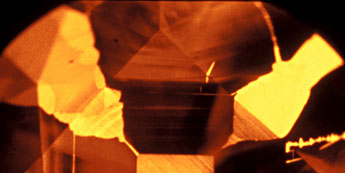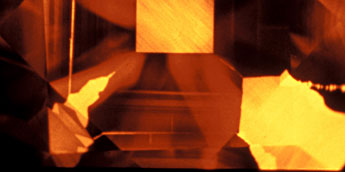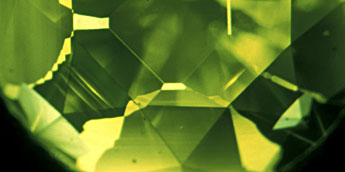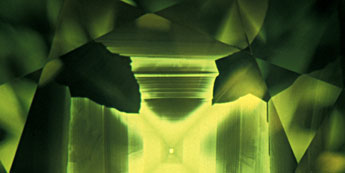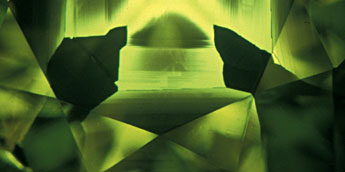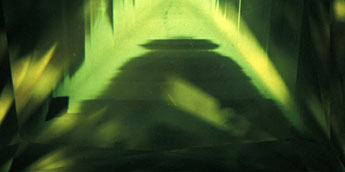| ü¤ Identification by Laboratory Techniques ü× Spectrophotometry In UV-visible range spectrophotometry, N3 centre (415nm) becomes a clue to distinguish natural from synthetic. N3 centre is a defect of three aggregated nitrogen atoms, which exists in almost all natural diamonds, but it is said that this defect cannot be produced by synthesis aiming at mass-production. To form N3 centre, fairly high temperature and high pressure is required and such condition may damage anvil on the pressing machine. Ni-N related defect may be detected in synthetic diamonds (Fig-1).
ü@Although FTIR analysis can separate the type of diamond, this is not enough to distinguish natural from synthetic. Characteristic identifying features of natural diamonds are existence of hydrogen-related detect and B2 centre. ü× X-ray Fluorescence Analysis An effective identification clue in X-ray fluorescence analytical method is a compositional analysis of inclusion in a diamond. The inclusion to be analysed should reach to the surface of the stone, as this method can analyse only the surface of a stone. It is quite rare for a crystal inclusion to exist on a polished surface of a diamond, but if it is the case, the included mineral can be identified accurately. Inclusions of metals that are used as metal solvents in synthetic diamond often reach to the surface of a stone. In this case, Fe, Ni and Co will be detected, which can prove the synthetic origin (Fig-2).
ü× Cathodo Luminescence Analysis This method makes observation of growth history of diamond possible and it is the most effective method to distinguish between natural and synthetic. The Diamond View developed by De Beers employs ultraviolet light instead of electron beam in Cathodo-Luminescence (CL) method, but its principle is very close to that of CL method. Although the Diamond View has a sophisticated operational performance, its image of fluorescence obtained in not as clear as that of CL method. Natural diamonds show various CL images and they can be used for individual discrimination. Synthetic diamonds show distinct sector zoning and an experienced operator can easily imagine the rough form of the synthesised crystal (Photo-9 and 10).
ü× Photoluminescence (PL) Analysis This is the most sophisticated analytical method to inspect atomic-level defects in diamond. Its effectiveness on detection of HPHT treatment in diamond has early been pointed out. From the research so far, this PL method has been proved to be highly effective to distinguish between natural and synthetic. The peaks thought to be derived from plastic deformation as well as point defects are often detected in natural diamonds, while the peaks thought to be related to metal solvents such as Ni may be detected in synthetic diamonds (Fig-3).
ü¤ Conclusion Synthetic diamond produced by HPHT method shows crystal habits that are different from natural diamond, as it uses metal solvents. It may also contain solvent metals as inclusions, which can be a proof for distinction from natural stone. In general identification tests, observation of inclusion, UV fluorescence, colour zoning and anomalous double refraction due to distortion are important. Laboratory techniques make the following analyses possible; 1 In FTIR analysis, the nitrogen content and its way of existence can be detected, which is an important indication for identification, 2 Ni-N related absorption may be observed in UV-visible spectrophotometry, 3 Metal flux such as Fe, Ni or Co may be detected in elemental analysis by EDXRF, 4 In observation by CL method, distinction between natural and synthetic can be made by the difference of growth history, 5 Certain metal flux or fluorescence peaks unique to natural stone can be detected by PL analysis. |
||||||||||||||||||||||||||||||||||||||
|
||||||||||||||||||||||||||||||||||||||






